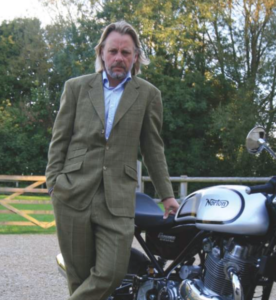Henry Cole was the drummer for a punk band. When he was in his late teens and early twenties, he was hooked on heroin. When he went into the entertainment business, everything changed.
He is an English director, producer, and host of TV shows. Also, he became known because he was in several motorcycle shows and because he had his own production company.
Also, in 2013, when he rode a Brough Superior on the Bonneville Salt Flats, he set a world record. He had the fastest land speed for a 750cc motorcycle made before 1995. He has worked hard on two books, the first of which will come out in 2018 and the second in 2020.

Janie Cole is Henry Cole’s wife
Find It. Fix It. Henry Cole is married to Janie Cole, who he loves very much. The couple is said to live in the Cotswold. His fans were eager for him to talk about his partner, but he kept avoiding the subject.
A 57-year-old TV host was born in 1965, so he may have been in other relationships before he found his life partner. But if you’re a big Cole fan, you know that he doesn’t let the media into his private life.
He is also written about in Wikipedia, where we can find out about the books he has written, the production company he runs, and the world record he has set.
Henry has kept his married life a secret, so no one knew when he married his loving wife. But he has shown up at some of the events with her. Also, there are a few pictures of the two of them together.
What is Henry Cole’s net worth?
Cole has worked in the entertainment industry for more than 30 years and has made a lot of money. His estimated net worth is between $1 million and $5 million. He was able to tell his side of the story to the whole world because he liked riding motorcycles.
Most fans know him from World’s Greatest Motorcycle Rides, The Motorbike Show, Shed and Buried, and other shows. He is also the CEO of Gladstone Motorcycle, a company that makes customized bikes. He started the business.
According to what has been said, he started his career as a cameraman for news stations. Later, he got the chance to make rockumentaries. After that, he mostly worked with heavy rock bands until he started directing TV ads. And slowly moved forward until he was making movies like Mad Dogs and Englishmen.
In 1995, he also started HCA Entertainment, an independent company that makes TV shows. It focuses on programs that are both interesting and true.
Henry Cole has how many kids? Who Are His Family Members?
Henry and his lovely wife Jaine have two children, Charlie and Tom. It was written about on the personal website of the English presenter. But it’s not just the four people in the family. Jelly Bean, their dog, also lives with them.
Cole’s family might be getting along well, and he might be showing his boys how much he loves motorcycles and other things he’s passionate about, like fishing and cycling.
When we looked at his Instagram, it was hard to see the pictures of his kids. But he keeps posting pictures of his motorcycles and him and his friends having fun. But Henry’s fans want to meet his family and interact with them if they can.
Henry Cole Bio/Wiki
In 1843, artist John Callcott Horsley made the first Christmas card that was sold to the public. It was made for Henry Cole.
Henry Cole’s parents, Captain Henry Robert Cole of the 1st Dragoon Guards and Laetitia Dormer, had him in Bath. In 1817, he was sent to Christ’s Hospital. When he graduated in 1823, he worked as a clerk for Francis Palgrave and then as a sub-commissioner for the Record Commission. Cole worked as a record typist, but he still had time to study watercolor painting with David Cox and show sketches at the Royal Academy. He lived with his father in a house that belonged to the author Thomas Love Peacock. Peacock kept two rooms in the house, and young Cole became his friend. Cole drew for him and helped him write reviews of performances of music. He also put Cole in touch with John Stuart Mill, Charles Buller, and George Grote. The friends used to talk twice a week at Grote’s house on Threadneedle Street. In 1831, a new Record Commission was made, and in 1833, Cole was given the job of sub-commissioner. Charles Purton Cooper, the secretary, got into a fight with the commission and with Cole. Cole then asked Charles Buller to protect him. Buller asked the House of Commons to set up a committee in 1836, which did a report against the current system. When William IV died on June 20, 1837, the commission ended. Cole wrote a lot of articles to back up Buller. Lord Langdale, who was the Master of the Rolls and ran the commission’s business, asked him to be in charge of the exchequer of pleas’ records.

Under the Public Record Office Act of 1838, the record office was set up in 1838, and Cole was one of the four senior assistant-keepers. He made a lot of records at the Carlton House Riding School, where he was sent on November 2, 1841, for that purpose. His reports about how bad this place was helped make it possible to build the building in Fetter Lane (begun in 1851). Cole’s work at the record company did not use up all of his energy. In 1838, with permission from his bosses, he became the secretary of a group working to improve the postal service. He was in charge of their newspaper, the Post Circular. He came up with the idea for it, and the first issue came out on March 14, 1838. He worked hard to get petitions and meetings going, and in 1839, Cobden asked him to be the secretary of the Anti-Cornlaw League. In August 1839, Parliament gave the power to carry out the new postal plan, and the treasury offered prizes for the best stamp ideas. Cole got one of the premiums. He went to the treasury to talk about details and worked there until the beginning of 1842 to figure out how the plan would work.
From 1837 to 1840, he worked as Rowland Hill’s assistant. During that time, he was a key part of the Penny Post’s launch. He is sometimes given credit for making the Penny Black, the first stamp in the world.
Cole sold the first commercial Christmas card in 1843. He asked the artist John Callcott Horsley to make the card’s picture.
A fake name for Felix Summerly
Cole was interested in industrial design, and under the name Felix Summerly, he designed a number of things that were made, including a teapot made by Minton that won a prize. As Felix Summerly, he also wrote a number of children’s books, such as The home treasury (1843–1855), A hand-book for the architecture, sculpture, tombs, and decorations of Westminster Abbey (1859), Beauty and the beast: an entirely new edition (1843), An alphabet of quadrupeds (1844), and The pleasant history of Reynard the Fox, told by the pictures by Albert van Everdingen (1843).
The Great Exhibition of 1851 was held in Hyde Park.
Cole used his membership in the Society for the Encouragement of Arts, Manufactures, and Commerce to get the government to back his campaign to raise standards in industrial design. Prince Albert agreed to help, and in 1847, the Royal Society for the Encouragement of Arts, Manufactures, and Commerce was given a royal charter (RSA). Under the support of Prince Albert, Cole put together a successful Exhibition of Art Manufactures in 1847. In 1848 and 1849, Cole put together even bigger shows.
Cole went to the 11th Quinquennial Paris Exhibition in 1849 and saw that there wasn’t an international exhibition. He saw that the RSA’s planned exhibitions for 1850 and 1851 could be turned into a larger international show. With Queen Victoria’s help, he set up the Royal Commission for the Exhibition of 1851 in 1850 to run the new show, with Prince Albert as its president.
The Great Exhibition of the Works of Industry of All Nations was held at the Crystal Palace in London’s Hyde Park from May 1 to October 15, 1851. It was a huge hit with the public and made a lot of money, thanks in part to how well Henry Cole ran it.
Cole was made fun of in Vanity Fair on August 19, 1871, as “King Cole.”
The V&A has a tiled mural
Cole was one of the Commissioners, and he helped decide that the £186,000 left over from the Great Exhibition would be used to improve science and art education in the UK. Land was bought in the South Kensington neighborhood and turned into “Albertopolis,” the center of a number of educational and cultural institutions. Henry Cole was put in charge of the Department of Practical Art, which was set up by the government to improve the quality of art and design education in Britain with an eye toward how it could be used in industry. In this role, he helped make the Victoria and Albert Museum what it is today. Before that, it was called the Museum of Ornamental Art and was in Marlborough House. Cole oversaw the museum’s move to its current location and, from 1857 to 1873, was the first director of what was then called the South Kensington Museum. Part of the museum that used to be called the Huxley Building was changed to the Henry Cole Building in 1974. It is now part of the V&A’s Henry Cole Wing.
Awards and legacies
Cole helped build the National Art Training School, which was renamed the Royal College of Art in 1896. He also helped build many other institutions in South Kensington, like the Royal College of Music and Imperial College London. In fact, the Imperial College Mathematics Department used to be in the Henry Cole Wing on Exhibition Road. When the building was given to the Victoria and Albert Museum, the department moved out.
Cole was given the CB and made a knight by Queen Victoria in 1875 for his work on the Great Exhibition.
[7] Cole was called “Old King” by the press, and it was said that the Queen and especially the Prince Consort were very close to him. When the Prince Consort needed help with one of his pet projects, he was heard to say, “We must have steam, get Cole.”
Cole lived and worked at 33 Thurloe Square, South Kensington, London, right next to the Victoria and Albert Museum. This is marked by a blue plaque from English Heritage.